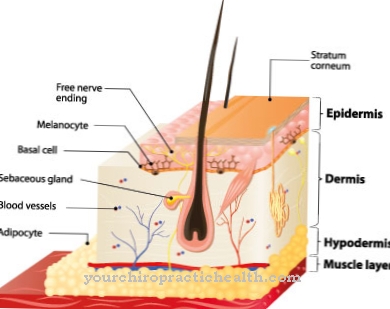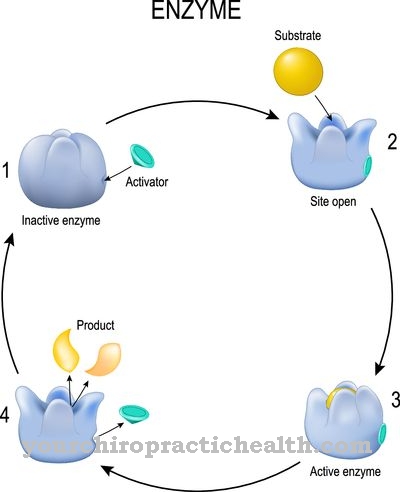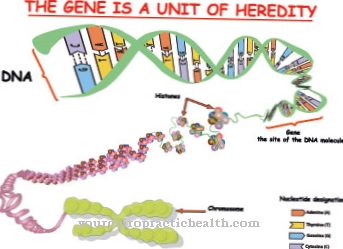Knee injuries and knee joint trauma occur when mechanical forces overstrain the physiological performance of the knee. The injuries can affect the ligament structures, the menisci, and articular cartilage. They arise from external violence, but can also be caused by peculiarities of the body.
What are knee injuries?

© bilderzwerg - stock.adobe.com
Movement puts mechanical stress on the knee joint. The range of motion is determined by the body structure. External forces or influences from within the body can force the joint to exceed its biomechanical limits during movement.
If knee joint trauma occurs as a result of external forces, direct or indirect forces play a role. A direct force acts on the joint when it is impacted or hit, an indirect force when it is bent, compressed or sheared. Incorrect or excessive loads can also be due to the constitution of the body and physiological processes.
If force acts against the plane of movement of the joint, cruciate ligaments, collateral ligaments or menisci can tear (rupture). A combined knee joint injury occurs when several of the anatomical components of the knee are affected by a rupture (“unhappy triad”).
causes
One cause of knee injuries is the action of external forces against the plane of motion of the joint. In addition, degenerative processes and anatomical misalignments can lead to knee injuries. External forces from a blow or impact cause bruises.
Twisting or shearing the knee joint leads to sprains. The traumas can occur through accidents in everyday life or as a result of sports injuries. Jumps, turns, and sudden stops, such as skiing or soccer, can cause meniscus damage or tears in the anterior cruciate ligament. Occasional dislocation of the kneecap occurs in patients under 20 years of age.
Rupture of the posterior cruciate ligament is possible as a result of a violent blow to the lower leg or knee. If forces act perpendicular to the natural direction of movement, the lateral ligaments can tear off. Degenerative signs of wear and tear of the menisci occur as a result of the natural aging process, obesity, one-sided stress with predominantly kneeling activity or genetic predisposition.
Damage to the ligaments can be caused by biomechanical malfunctions due to misaligned axes (knock knees, bow legs). Damage to the articular cartilage (arthrosis) is the result of meniscus and ligament trauma or is itself a result of degenerative wear.
Symptoms, ailments & signs
Symptoms of knee injuries allow conclusions to be drawn about certain types of injuries in many cases. Clear signs of a fracture of the kneecap (patella) are an axial misalignment, unnaturally great mobility and recognizable bone fragments. Signs of a kneecap dislocation (kneecap dislocation) are pain in the front of the knee and excessive outward movement of the kneecap.
If the meniscus tears, there is severe pain in the knee and swelling. A noise may be heard. The affected knee joint can only be moved to a limited extent and can no longer be fully loaded. The main problem is stretching the knee. The feeling of instability in the knee joint when walking or running is typical.
Ligaments in the knee can be pulled and partially or completely torn. The symptoms are pain in the area of the affected ligament and significant swelling. The knee's ability to move and exercise stress is restricted. If there is pain in the unloaded knee joint, there may be damage to the cartilage. Typical complaints indicate a cruciate ligament tear.
It causes significant pain and can be heard as a cracking noise. There is severe swelling and the feeling that the lower leg is shifting against the thigh. The knee is unstable and prevents a safe gait. The joint can suddenly buckle. Swelling, overheating and reddening of the skin are clear signs of a bruise on the knee. In many cases, a bruise is also visible.
Diagnosis & course
Tears in the meniscus cause pain at the joint space that continues into the hollow of the knee. They are particularly strong under pressure and stress. Rotational movements of the knee are also painful. If the meniscus is pinched, the joint can become blocked. Joint effusion may be palpable.
An arthroscopy is usually done to confirm the diagnosis. Cruciate ligament ruptures cause acute pain and lead to an effusion in the joint. It is bloody in the first time after the injury and makes the knee swell a lot. Various tests are used to check whether the ligaments still offer sufficient support when the lower leg moves against the thigh.
In the case of damage to the ligaments as well as meniscus ruptures, x-rays or magnetic resonance imaging are made for diagnostic clarification so that damage to the bones can be excluded.
Complications
Knee injuries can be very diverse, so the complications associated with them can also be very different. Most knee injuries result from overstretching the ligaments. If individual ligaments within the knee are overstretched too much, they can tear. If such a clinical picture remains untreated, various complications can be expected.
The torn ligaments can no longer grow together on their own without surgery, so the pain persists permanently. The knee joint may become inflamed, causing an abscess to form. An abscess is a collection of pus fluid that, in particularly severe cases, can even cause blood poisoning. In such a case there is an acute danger to life. Treatment by a specialist is inevitable in such a case, otherwise the complications mentioned above will worsen considerably.
Of course, one of the possible knee injuries is a fracture. An operation may even be necessary, as otherwise a fracture cannot heal properly or grow together. As knee injuries can cause a variety of complications, it is advisable to see a doctor early to prevent the symptoms from getting worse. The complications mentioned above can only be avoided through professional treatment.
When should you go to the doctor?
The most important criterion for whether to see a doctor is the extent of the injury. If there is an obvious fracture of bone substance or an instability that indicates a ligament or tendon injury, the doctor is the right contact. The same applies to severe pain, which does not go away even with cooling and immobilization. Here, too, a doctor's visit is necessary, for example, to rule out a meniscus injury. Heavy bleeding that is difficult to stop is also a cause. This applies in particular to heavily contaminated wounds and the possible need for an injection against tetanus.
In many cases, a knee injury can heal itself without a doctor's visit. Especially in children with abrasions, cleaning, covering and, if necessary, protecting them is often sufficient. It looks different when a wound has become infected. This can often be seen well by the layperson from the classic signs of inflammation. Redness, overheating, swelling and a throbbing pain are possible signs of infection, as well as a yellowish secretion from the wound. It is also important to see a doctor if there are foreign objects in the wound that the patient cannot remove himself. Contact with corrosive substances or fire is another reason to have a close look at the skin of the knee.
Treatment & Therapy
The treatment of knee joint trauma depends on the anatomical structures involved, the biological age, the general state of health and the patient's level of activity. Tears in the menisci are treated as part of arthroscopy.
If patients are younger than 40 years, a suture is promising. Otherwise the damaged tissue is removed as gently as possible. The more extensive the meniscus resection, the higher the risk of wear and tear on the articular cartilage. Cruciate ligament tears are treated both conservatively and surgically. Conservative treatment is often enough. The knee is supported by an orthosis and is sufficiently stable again after 6 weeks.
A puncture of the bone in the area of the cruciate ligament is also possible, so that emerging stem cells can help heal the injury. In younger athletic patients, the cruciate ligament tear is treated surgically. The type of injury determines whether the ligament is sutured or replaced with a cruciate ligament repair. For a cruciate ligament surgery, the body's own replacement tissue or synthetic prostheses are used. A tear of the cruciate ligament on the bone is fixed with a screw or wire suture.
After a surgical procedure, the leg is stabilized with an orthosis. Resilience occurs gradually and is fully achieved after 10-12 months. Treatment of a torn cruciate ligament is always accompanied by physiotherapy. The focus is on strengthening the muscles and training coordination.
You can find your medication here
➔ Medicines for joint painOutlook & forecast
The prospect of a cure in the case of knee injuries is to be assessed according to the individual circumstances. In most cases, with rapid and comprehensive medical care, symptoms will be free after a few weeks or months. The sooner treatment takes place and the knee is sufficiently spared, the better the course of the disease.
Conservative therapy is usually sufficient. Surgical intervention is necessary for severe injuries. This is associated with risks and side effects. If there are no further complications, a favorable prognosis can be expected.
Without treatment, the person concerned often suffers from severe and increasing pain. Some patients have the potential to be cured without further medical intervention. However, this is the exception. Rather, there is a risk of permanent disturbances in joint activity, irreparable damage to the bones and cartilage and a decrease in physical resilience.
Knee injuries can cause lifelong instability of the knee. In spite of all efforts, chronic secondary diseases can occur. These trigger an unfavorable prognosis, as an increase in impairments is to be expected over the life span. There is also the risk of not being able to carry out sports or professional activities as usual. This leads to emotional stress and increases the likelihood of mental illness.
prevention
Gentle movement sequences are learned to prevent knee injuries. The knee is protected if the flexion angle and axis are consciously controlled during exercise. Coordination and muscle training are essential for the functionality and stability of the knee.
Holistic training of the joint is possible when cycling. Weight and eating habits are also important for knee health. After injuries, elastic bandages have a stabilizing effect.
Aftercare
Knee injuries require consistent follow-up care to ensure optimal regeneration. This is ensured by several groups of people. On the one hand, it is the attending physician, such as the sports medicine specialist or orthopedic surgeon, who coordinates the follow-up care and possibly orders another imaging procedure by a radiologist.
On the other hand, it is the physiotherapist who reactivates the functionality of the joint and surrounding structures through his treatment. Thirdly, the cooperation of the patient is also required, who, for example, regularly carries out physical therapy exercises at home or in the fitness studio and can thus ensure the success of the treatment.
Rest is very important with regard to optimal regeneration. The duration is decided by the physiotherapist and doctor, but it is the patient who has to follow these instructions. Athletes in particular often have a tendency to want to get back into training and competition too early. In order to avoid a relapse or delayed regeneration, it is better to do the prescribed physiotherapy exercises.
These serve to strengthen the muscles surrounding the joint and also restore mobility in the knee joint as best as possible. If the knee joint injury is accompanied by a suture, protection is particularly important. Stability is an important factor when it comes to the knee joint. Corresponding splints must therefore also be worn consistently as part of aftercare.
You can do that yourself
The relief of knee injuries can be accompanied by a medical treatment with various options. However, in order not to suffer permanent damage, it is essential to get a medical examination and medical care.
If possible, the knee should not be subjected to any or only minimal load during treatment. If the state of health permits, locomotion can be carried out slowly and carefully. Daily physiotherapy exercises, carried out in consultation with a therapist, will help with recovery. It is imperative to wear healthy shoes. The use of shoes with high heels or the wrong size should be avoided as a matter of principle. In order not to subject the knee or leg to unnecessary stress, closed, comfortable and breathable shoes are recommended.
With a knee injury, compensatory movements are often made, which lead to a poor posture of the body. The person affected should ensure in good time that the healthy body regions are not exposed to excessive or one-sided loads. Compensatory movements are necessary with the aim of preventing muscle or bone damage. In the event of a knee injury, the everyday obligations must be restructured so that relief can take place. The help of people in the immediate vicinity should be used.It is also important for those affected to pay attention to their emotional well-being.



























